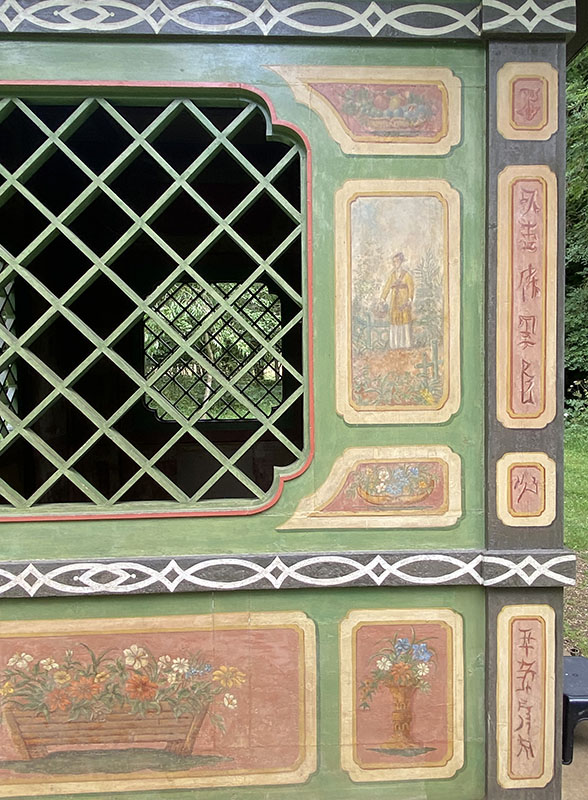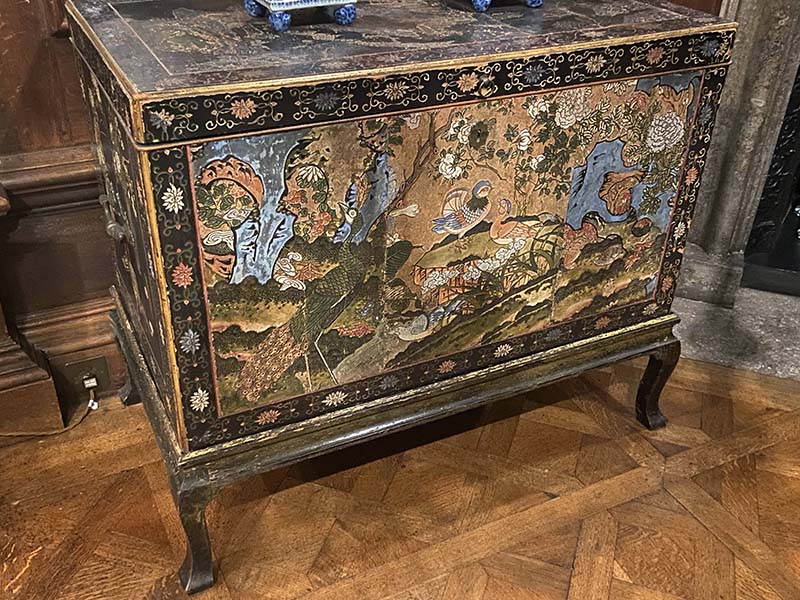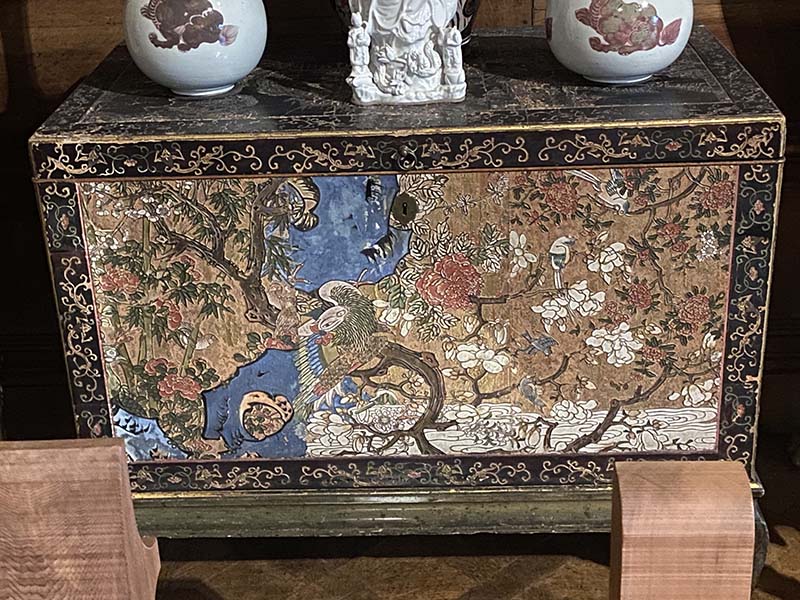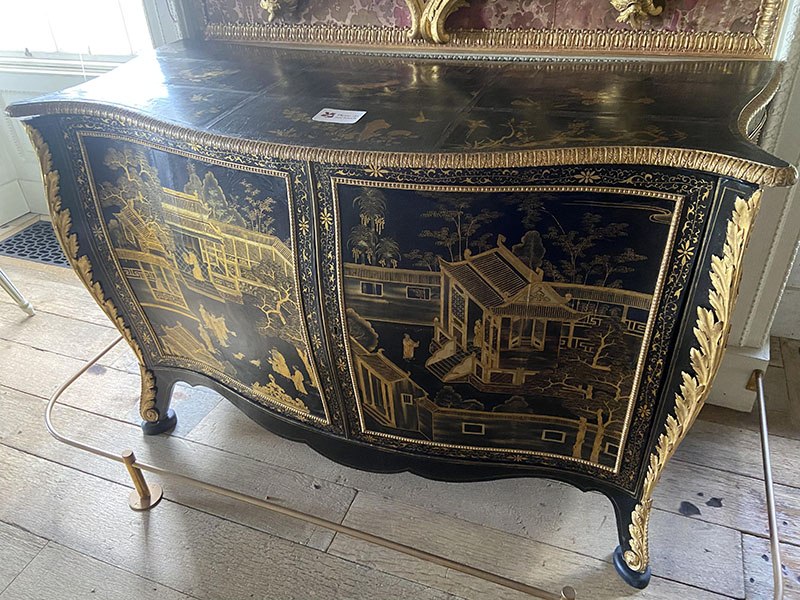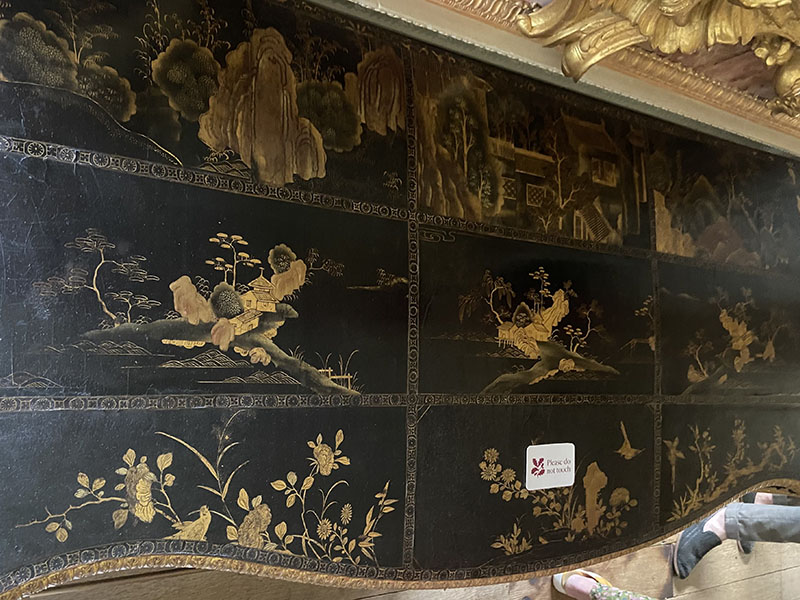Seeking Asia in British Country Houses: An Attingham Summer School Report
by Susan Eberhard
Many dear mentors have enthusiastically recommended the Attingham Summer School to me over the years. I am fortunate to have joined the program this summer as the recipient of the Decorative Arts Trust’s Continuing Education Scholarship. The 16 days in England were packed with multi-directional, multi-disciplinary streams of content. We visited about 20 houses and sites in Sussex, Buckinghamshire, Derbyshire, Northamptonshire, Norfolk, Cambridgeshire, and Lincolnshire.
I am an art historian specializing in Chinese decorative arts and material culture and their global exchange from 1600 to 1900. Thus, the questions and interests I brought to Attingham were, I soon discovered, oblique to the primary stories that British country houses tell about themselves today. Many of the Asian and Asian-inspired objects in the houses were originally collected and commissioned by their owners in the late 17th and 18th centuries. For my own research purposes, they are often quite valuable as primary sources documented through inventories or bills of sale.
I became interested in how malleable imported Asian objects and design were within these spaces. The most compelling example to me was the imitation and recycling of imported Chinese and Japanese lacquer. Asian designs derived from lacquer were clearly important sources of creative inspiration to British artists, designers, and architects in the late 17th and early 18th century. An incredible example is the Chinese House at Stowe (figure 1), which was constructed by 1738. It is thought to have been designed by William Kent, and was decorated by Francesco Sleter, an Italian painter active in England. The original decorative program was refreshed and changed in 1825 to its current appearance during a period of chinoiserie revival in British fashion, but an early-18th-century elite visitor, Jemima, the Marchioness Grey, noted that the interior was originally outfitted with old lacquer screens that had been cut up and reused. Since there is no evidence that anything was attached to the interior walls, it is more likely, art historian Emile de Bruijn argues, that Sleter instead painted (or “japanned”) the interior to resemble a pastiche of re-used lacquer screens.1 The paintings were thus in imitation of late-17th-century “lacquer rooms,” such as one at the Rijksmuseum which was made for Princess Albertine Agnes of Orange and Nassau around 1695. It is important, moreover, that the recorded observer of the 18th-century interior was a woman, as often chinoiserie and Asian objects were connected to women patrons and viewers.
We also saw the recycling of lacquer panels at Chatsworth in the late 17th century. English cabinetmaker Gerrit Jensen was paid in 1692 for “japanning” a room known as the “Japan Closet,” which traveler and diarist Celia Fiennes, another period woman observer of Asian-inspired spaces, described as “wainscoted with hollow burnt Japan.” The latter was the period term for Chinese coromandel or Kuancai (“cut colors”) lacquer screens.2 The closet was dismantled in 1700 when Chatsworth’s west front was rebuilt, and the panels were re-used, likely by Jensen, to “japan” three cabinets now installed in the State Drawing Room, which dates to c. 1705. Two of the cabinets demonstrate how the lacquer panels were spliced together in rectangular fragments. Sections of three folding screen panels were placed on the front of the cabinet (figure 2). One of the panels features a peacock with its plumes tucked, the second a wonderful pair of male and female wood ducks, and the third a pair of smaller birds to the lower left of a rocky landscape. The repetition of blue, green, pink, white, and red tones across the three panels and some subsequent finishing on the part of the cabinetmaker allow the eye to smooth over the two vertical seams that punctuate the front-facing side. Yet once you notice them, they are quite obvious. They indicate the strategic reuse of the material by preserving an uneasy sense that the scene is not continuous. On another cabinet, with a façade also covered with three sections of a Kuancai screen, the phoenix in the central panel has been installed upside-down (figure 3). The cabinetmaker’s logic here was likely to allow for continuity of the swirling clouds at the bottom of the central and right panel, while sacrificing the directionality of the primary motif. The workshop extended the phoenix’s green feathers across the seam to the right. The rearticulation of scenes across three formats—folding screen, room interior, and cabinets—demonstrates the value of recycling the lacquer panels. From screen to wall decoration to case furniture, this adaptive reuse demonstrates the malleability of Asian and Asian-inspired objects within the evolving spaces and functions of the British country house.
The Chatsworth cabinets offer an interesting contrast with a pair of boule commodes at Uppark (figure 4). They were made much later in the 18th century with the same principle of adapting Chinese lacquer, in this instance a finely-layered black-and-gold lacquer. They are attributed to the French émigré cabinetmaker Pierre Langlois and dated c. 1765. Several similar commodes have been attributed to Langlois’ workshop, including examples at Polesden Lacey, Powis Castle, and the Legion of Honor of the Fine Arts Museums of San Francisco (formerly at Strawberry Hill). In contrast to the Chatsworth cabinets, the Uppark commodes have two cut lacquer panels attached to the front. The scenes, which might be regarded as fragments, are thematically similar but outlined by borders as well as the opening of the doors. Fragments selected from different parts of a folding screen were arranged in a three-by-three grid to form the top (figure 5). The rear register contains painterly landscape scenes that clearly expand beyond the cut frame, the middle register bearing a series of self-contained landscapes, and the bottom register includes a series of sparse bird-and-flower scenes. Order has been imposed by the cabinetmaker, in terms of a descending level of density in juxtaposing the compositions.
This small set of objects highlight the constant transformation of material culture and the intersection of art with an ecology of materials, environments, and social demands that can be readapted as needed. Yet these objects continue to bear the physical traces of their prior states and meanings.
I will remain grateful for the Trust’s support of this opportunity. I am also thankful to our course directors, Tessa Wild and David Adshead, for their guidance, the course coordinator Zuzanne Stark for her kindness and good spirits, and our many hosts and tutors for sharing and discussing objects, spaces, histories and presents with us.
1. Emile de Bruijn, “Found in Translation: The Chinese House at Stowe,” Apollo (June 2007): 54.
2. “Jensen, Gerrit,” British and Irish Furniture Makers Online (BIFMO), last updated 28 May 2023.
Susan Eberhard is a lecturer in Asian Art History at Cal Poly San Luis Obispo. Learn more about her research in this magazine article and this lecture recording.
About The Decorative Arts Trust Bulletin
Formerly known as the "blog,” the Bulletin features new research and scholarship, travelogues, book reviews, and museum and gallery exhibitions. The Bulletin complements The Magazine of the Decorative Arts Trust, our biannual members publication.
Click Images to Enlarge
Did you know that clicking on the images in Bulletin posts will allow you to get a closer look? Simply click on an image, and a larger version will open in a pop-up window.








